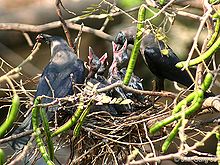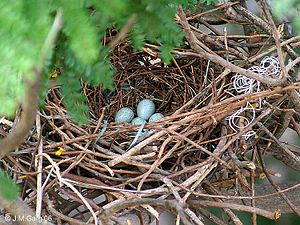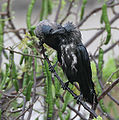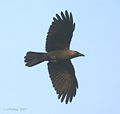- House Crow
-
House Crow 
Conservation status Scientific classification Kingdom: Animalia Phylum: Chordata Class: Aves Order: Passeriformes Family: Corvidae Genus: Corvus Species: C. splendens Binomial name Corvus splendens
Vieillot, 1817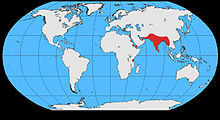
The House Crow (Corvus splendens), also known as the Colombo Crow is a common bird of the Crow family that is of Asian origin but now found in many parts of the world, where they arrived assisted by shipping. It is between the Jackdaw and the Carrion Crow in size (40 cm in length) but is relatively slimmer than either. The forehead, crown, throat and upper breast are a richly glossed black, whilst the neck and breast are a lighter grey-brown in colour. The wings, tail and legs are black. There are regional variations in the thickness of the bill and the depth of colour in areas of the plumage.
Contents
Taxonomy
In the dry parts of South Asia and Iran the subspecies C. s. zugmayeri is found and this has a very pale neck collar. The nominate race is found in India, Nepal and Bangladesh and has a grey neck collar. In southern India, the Maldives (sometimes separated as maledivicus) and Sri Lanka, the subspecies C. s. protegatus is darker grey. The darkest form however is the Myanmar form C. s. insolens and lacks the grey collar.[2]
Distribution and habitat
It has a widespread distribution in southern Asia, being native to Nepal, Bangladesh, India, Pakistan, Sri Lanka, Maldives and Laccadive Islands, South West Thailand and coastal southern Iran. It has been introduced to East Africa around Zanzibar (around 1897[3]) and Port Sudan, and arrived in Australia via ship but has up to now been exterminated. Recently it has made its arrival in Europe, and has been breeding in the Hook of Holland since 1998 An individual of this species has been present in Cork Harbour on the south coast of Ireland since early September 2010. .[4]
In the New World, a small population of House Crows is established in the area around St. Petersburg, Florida[5].
It is associated with human settlements in all of its range, from small villages to large cities. In Singapore there was a density of 190 birds/km2 in 2001 with efforts to suppress the population in planning.[6][7]
Due to a human population explosion in the areas it inhabits, this species has also proportionately multiplied. Being an omnivorous scavenger has enabled it to thrive in such circumstances.
The invasive potential for the species is great all over the tropics. This species is able to make use of resources with great flexibility and appears to be associated with humans, and no populations are known to exist independently of humans.[8]
Behaviour
Diet
It feeds largely on refuse around human habitations, small reptiles and other animals such as insects and other small invertebrates, eggs, nestlings, grain and fruits. Crows have also been observed swooping down from the air and snatching baby squirrels. Most food is taken from the ground, but also from trees as opportunity arises. It is a highly opportunistic bird and given its omnivorous diet, it can survive on nearly anything that is edible. These birds can be seen near marketplaces and garbage dumps, foraging for scraps.
Nesting
At least some trees in the local environment seem to be necessary for its successful breeding although they occasionally nest on telephone towers.[9] It lays 3-6 eggs in a typical stick nest, and occasionally there are several nests in the same tree. In South Asia they are parasitized by the Asian Koel. Peak breeding in India as well as Peninsular Malaysia was from April to July. Large trees with big crowns are preferred for nesting.[10]
Roosting
House Crows roost communally near human habitations and often over busy streets. A study in Singapore found that the preferred roost sites were in well-lit areas with a lot of human activity, close to food sources and in tall trees with dense crowns that were separated from other trees. The roost sites were often enclosed by tall buildings.[11]
Voice
The voice is a harsh kaaa-kaaa.[2]
Relationship to humans
It is suspected that paramyxoviruses, such as PMV 1 that causes of Newcastle disease[12] may be spread by Corvus splendens. Outbreaks in India of Newcastle disease were often preceded by mortality in crows.[13] They have also been found to carry Cryptococcus neoformans which can cause cryptococcosis in humans.[14]
Crows in Tanzania curiously showed an absence of blood parasites although some species such as Trypanosoma corvi have been first described from this species.[15]
-
sleeping at night in Kolkata, West Bengal, India.
References
- ^ BirdLife International (2004). Corvus splendens. 2006. IUCN Red List of Threatened Species. IUCN 2006. www.iucnredlist.org. Retrieved on 12 May 2006. Database entry includes justification for why this species is of least concern
- ^ a b Rasmussen, PC & JC Anderton (2005) Birds of South Asia: The Ripley Guide. Smithsonian Institution and Lynx Edicions. Vol 2. p.598
- ^ Cooper, John E. (1996) Health studies on the Indian house crow (Corvus splendens) Avian Pathology 25(2):381
- ^ Ottens, G. (2003) Background and development of the Dutch population of House Crows Corvus splendens. Limosa 76(2):69-74
- ^ Pranty, W. 2004. Florida’s exotic avifauna: a preliminary checklist. - Birding, August 2004: 362:372.
- ^ Brook, B.W., Sodhi, N.S., Soh, M.C.K., Lim, H.C. (2003) Abundance and projected control of invasive house crows in Singapore. Journal of Wildlife Management 67(4):808-817
- ^ Ryall, C., 2002. Further records of range extension in the House Crow Corvus splendens. BOC Bulletin 122(3): 231-240
- ^ Nyari, A., Ryall, C. and Peterson, A. T. 2006. Global invasive potential of the house crow Corvus splendens based on ecological niche modeling. J. Avian Biol. 37:306-311.
- ^ Lamba, B.S. 1963. The nidification of some common Indian birds. Part I. J. Bombay Nat. Hisl. Soc. 60:121-133
- ^ Soh MCK, NS Sodhi, RKH Seoh, BW Brook (2002) Nest site selection of the house crow (Corvus splendens), an urban invasive bird species in Singapore and implications for its management. Landscape and Urban planning 59:217-226
- ^ Kelvin S.-H. Peh and Navjot S. Sodhi (2002) Characteristics of Nocturnal Roosts of House Crows in Singapore. The Journal of Wildlife Management 66(4):1128-1133
- ^ Roy, P., Venugopalan, A.T., Manvell, R. 1998 Isolation of Newcastle disease virus from an Indian house crow. Tropical animal health and production 30 (3):177-178
- ^ Blount, W.P. (1949). Diseases of Poultry. (London, Balliere, Tindall and Cox).
- ^ S. Gokulshankar, S. Ranganathan, M. S. Ranjith and A. J. A. Ranjithsingh (2004) Prevalence, serotypes and mating patterns of Cryptococcus neoformans in the pellets of different avifauna in Madras, India. Mycoses, 47:310–314
- ^ Dirie, M.F., Ashford, R.W., Mungomba, L.M., Molyneux, D.H. & Green, E.E. (1990). Avian trypanosomes in Simulium and sparrowhawks (Accipiter nisus). Parasitology, 101,243-247.
External links
- House Crow Monitor
- Bibliography
- House Crow video, photos & sounds on the Internet Bird Collection
- Invasives database
Extant species of family Corvidae Kingdom: Animalia · Phylum: Chordata · Class: Aves · Subclass: Neornithes · Superorder: Neognathae · Order: PasseriformesFamily Corvidae Choughs Treepies PlatysmurusTemnurusOriental
magpiesOld World jays PtilostomusStresemann's
BushcrowZavattariornis
Categories:- IUCN Red List least concern species
- Corvus
- Birds of Asia
- Birds of Bangladesh
- Birds of Pakistan
- Birds of Africa
- Birds of Kenya
- Birds of Western Australia
- Birds of Thailand
- Birds of Sri Lanka
- Urban animals
Wikimedia Foundation. 2010.
Look at other dictionaries:
house crow — indinė varna statusas T sritis zoologija | vardynas atitikmenys: lot. Corvus splendens angl. house crow vok. Glanzkrähe, f rus. блестящий ворон, m pranc. corbeau familier, m ryšiai: platesnis terminas – varnos … Paukščių pavadinimų žodynas
house crow — noun : a common crow (Corvus splendens) of India familiar as a scavenger and resembling the hooded crow of Europe * * * a black and gray crow, Corvus splendens, of India … Useful english dictionary
house crow — a black and gray crow, Corvus splendens, of India. * * * … Universalium
Crow — For other uses, see Crow (disambiguation). Crow American Crow (Corvus brachyrhynchos) Scientific classification Kingdom … Wikipedia
Crow's Nest Natural Area Preserve — Crow s Nest Point looking northeast Location Stafford County, Virginia, USA … Wikipedia
Crow Nation — Crow Apsáalooke Total population 12,000 enrolled members Regions with significant populations Montana reservation and cities, and Albuquerque, Denver, Lawrence, Bismarck, Spokane, Seattle, Chicago … Wikipedia
Crow-stepped gable — Crow steps on a Scottish baronial building. A Stepped gable, Crow stepped gable, or Corbie step is a stair step type of design at the top of the triangular gable end of a building. The top of the parapet wall projects above the roofline and the… … Wikipedia
House Stark — is a fictional noble family from George R. R. Martin s A Song of Ice and Fire . Several of the main point of view characters of the series are members of House Stark. House Stark is the principal noble house in the North; many lesser houses are… … Wikipedia
Crow House — may refer to: in the United States (by state then city) Habicht Cohn Crow House, Arkadelphia, Arkansas, listed on the National Register of Historic Places in Clark County, Arkansas Crow House (Star City, Arkansas), listed on the National Register … Wikipedia
Crow War — Part of the American Indian Wars Crow Indians Firing Into The Agency … Wikipedia
-



